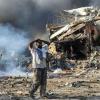
Breaking News
Deep Gratitude: The Energy for Your Life
 Ukraine frontline report – bitter fighting as Russian forces surround key cities | BBC News
Ukraine frontline report – bitter fighting as Russian forces surround key cities | BBC News
 Who Is Ready To Die for Trump's Gaza Plan? So Far, Nobody
Who Is Ready To Die for Trump's Gaza Plan? So Far, Nobody
 US Bombs Somalia for 100th Time This Year
US Bombs Somalia for 100th Time This Year
Top Tech News
 Mach-23 potato gun to shoot satellites into space
Mach-23 potato gun to shoot satellites into space
 Blue Origin Will Increase New Glenn Thrust 15-25% and Make Rocket Bigger
Blue Origin Will Increase New Glenn Thrust 15-25% and Make Rocket Bigger
 Pennsylvania Bill – 'Jetsons Act' – Aims To Green-Light Flying Cars
Pennsylvania Bill – 'Jetsons Act' – Aims To Green-Light Flying Cars
 New Gel Regrows Dental Enamel–Which Humans Cannot Do–and Could Revolutionize Tooth Care
New Gel Regrows Dental Enamel–Which Humans Cannot Do–and Could Revolutionize Tooth Care
 Researchers want to drop lab grown brains into video games
Researchers want to drop lab grown brains into video games
 Scientists achieve breakthrough in Quantum satellite uplink
Scientists achieve breakthrough in Quantum satellite uplink
 Blue Origin New Glenn 2 Next Launch and How Many Launches in 2026 and 2027
Blue Origin New Glenn 2 Next Launch and How Many Launches in 2026 and 2027
 China's thorium reactor aims to fuse power and parity
China's thorium reactor aims to fuse power and parity
 Ancient way to create penicillin, a medicine from ancient era
Ancient way to create penicillin, a medicine from ancient era
Tokamak Energy plans net electricity production fusion by 2025...

Experimental and theoretical research has shown 'spherical' tokamaks to be a "fast route to fusion" compared with more "conventional" tokamak devices such as Joint European Torus (JET), according to David Kingham, chief executive of Tokamak Energy.
"By pursuing this route, fusion researchers around the world, including at Tokamak Energy, are developing new materials and technologies to help us get fusion power into the grid by 2030," Kingham told a meeting held last week by the International Energy Agency (IEA) on developing fusion power. Tokamak Energy was invited as "one of the three most promising fusion concepts", along with General Fusion and Tri-Alpha Energy.
The UK's Tokamak Energy grew out of Culham Laboratory, home to JET - the world's most powerful tokamak - and the world's leading centre for magnetic fusion energy research. Tokamak Energy's technology revolves around high temperature superconducting (HTS) magnets, which allow for relatively low-power and small-size devices, but high performance and potentially widespread commercial deployment.

 Unbanked In A Connected World
Unbanked In A Connected World

